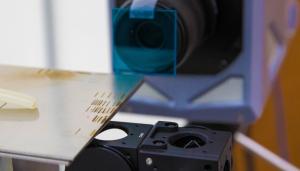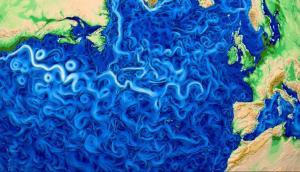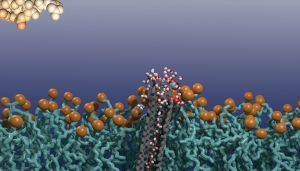LAB REPORT
Science and Technology Making Headlines
March 22, 2019


Danger from above: while asteroid impacts have a very low likelihood of happening, they could cause a lot of damage if they were to occur. Courtesy: iStock/Paul Paladin
Stopping a city killer in its tracks
We live on a planet whose orbit is frequently crossing paths with tons of ancient cosmic debris.
Space debris of a certain size crossing Earth’s path is something various agencies are very concerned about. NASA’s Planetary Defense Coordination Office, for example, is tracking the sky hoping to spot a range of potentially hazardous objects, or PHOs, that will come within 8 million kilometers (5 million miles) of Earth’s orbit — which is close by astronomical standards.
In general, the office tracks objects that are at least 30 meters (about 100 feet) across, which at that size will cause “significant damage” if they impact the planet. However, those 30-meter-long objects, aren’t enough to cause planetary devastation. For example, the Chicxulub impactor that is said to have killed off the dinosaurs was 12.1 kilometers (7.5 miles) across.
At 30 meters or above, though, they could cause major damage to a populated area. As Megan Bruck Syal, a planetary defense researcher at the Lawrence Livermore National Laboratory, said it’s these “city killers” that her colleagues worry about. These include the next 200- to 330-foot rocky meteor, or a similar 164-foot iron collider that creates something similar to a meteor crater upon impact.
According to Bruck Syal, city-killer-sized asteroids could be easily “disrupted and well-dispersed” — as in, shattered into pieces — in a way that no sizable fragments slam into Earth.

Under a new initiative, LLNL will share its expertise in advanced clean energy technologies with city governments, community groups and nonprofits to identify energy needs and bring research and technologies developed at the Laboratory to areas that need it most. Credit: George Kitrinos
Going green for others
Lawrence Livermore launched a new program to share solutions for sustainable and affordable energy infrastructure with local communities.
Specifically, the Lab will share its research and technology expertise in clean energy technologies — including microgrids, energy-efficient “smart” buildings and electric vehicles — with local governments, community groups and nonprofits to identify energy needs.
“Several California agencies are looking to support these types of collaborations, and it’s a real opportunity to deploy our technologies in ways that are tailored to specific community needs,” LLNL Systems Analyst Robin Wong said. “It’s a co-development strategy. The technology is mature enough that we can work with communities to understand how it can be used to solve specific issues. At the same time, Lab experts get to see these technologies operate in real-world scenarios to better understand how these tools can be used to solve local energy challenges.”


A team led by LLNL materials scientist Aiden Martin created a custom-built, two-beam metal 3D printer to investigate how multiple lasers work together to build a part and what can occur during operation to cause defects. Photo by Julie Russell/LLNL
Identifying a weak link
Under a project funded by national 3D printing development partner America Makes, LLNL is developing a commercial-grade, metal additive manufacturing system. Designed and built in collaboration with GE Global Research, the aim of the project is to develop a platform that could cut metal processing times in half.
A research-grade, open-architecture metal 3D printer developed with funding from the U.S. Air Force Research Laboratory is to be used as the foundation of this new commercial system. Currently, LLNL scientists are working with this early stage system to characterize the causes of defects in 3D-printed parts.
LLNL’s multi-beam 3D printer development is built on discoveries made by Ibo Matthews and the Laser Materials Group at LLNL. One such breakthrough made by the team is a characterization of the “spatter effect” in laser-melted powder, whereby unmelted particles are dragged into the melt-pool behind the laser, creating impurities.

DOE's E3SM is a state-of-the-science Earth system model development and simulation project to investigate energy-relevant science using code optimized for DOE's advanced computers. A new model evaluation method will help systems like E3SM predict more accurate future climate change.
Peering deeper into the crystal ball
Scientists and their models agree: The world is getting warmer and the climate is changing as a result of growing greenhouse gas emissions. But even the best models can't say exactly what the planet's climate systems will look like in 2100.
But by looking at which climate mechanisms and variables drive uncertainty among climate models, a Lawrence Livermore scientist and collaborators have found a way to narrow the range of predictions.
Even when they're fed the same data sets, climate models produce different ranges of possibilities. If scientists can tweak models to more closely replicate the current climate's most important variables, then they can shrink the range of future climate scenarios.
"Emergent constraints will help developers make models that better predict the future because they identify which observations they should get their model to replicate," LLNL climate scientist Steve Klein. “This is particularly valuable on the subject of clouds, for which it is not easy to know which of the many diverse aspects of the clouds we observe are relevant to their future evolution."


The image shows a cross-section of a lipid bilayer with an embedded carbon nanotube porin resting on a silicon nanoribbon sensor surface. The porin contains a single hydrogen-bonded chain of water molecules that relays protons to the nanoribbon. A lipid bilayer protects the sensor from fouling by proteins and other biomolecules. Image by Yuliang Zhang/LLNL
New tool just makes sense
LLNL researchers have developed a new biological sensor that could help clinicians better diagnose cancer and epilepsy.
Biological sensors monitor small molecules, ions and protons and are vital as a medical diagnostic. Even the simplest signals, such as intracellular pH level, can provide important information for the medical community. For example, acidification of tumors because of elevated glucose uptake and lactic acid release is a biomarker of cancer cells. Likewise, acidification of extracellular fluid is one of the key processes during epileptic seizures.
But manmade biosensors have limitations such as biocompatibility and fouling (the accumulation of unwanted materials that impede or interfere with the function of the molecule). Biological systems are adept at protecting and separating vital components of biological machinery with semipermeable membranes that often contain defined pores and gates to restrict transmembrane transport only to specific species.
Learning from biology, the LLNL team created a pH sensor by integrating silicon nanoribbon transistor sensors with an antifouling lipid bilayer coating that contains proton-permeable carbon nanotube porin (CNTP) channels and demonstrated robust pH detection using those sensors in a variety of complex biological fluids.





